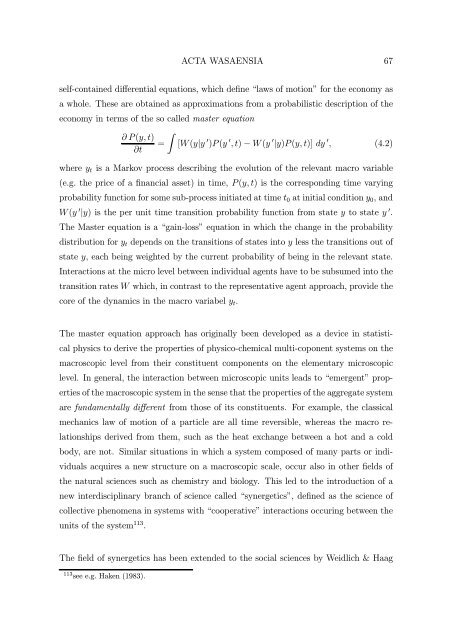BERND PAPE Asset Allocation, Multivariate Position Based Trading ...
BERND PAPE Asset Allocation, Multivariate Position Based Trading ...
BERND PAPE Asset Allocation, Multivariate Position Based Trading ...
You also want an ePaper? Increase the reach of your titles
YUMPU automatically turns print PDFs into web optimized ePapers that Google loves.
ACTA WASAENSIA 67self-contained differential equations, which define “laws of motion” for the economy asa whole. These are obtained as approximations from a probabilistic description of theeconomy in terms of the so called master equation∂ P (y, t)= [W (y|y )P (y ,t) − W (y |y)P (y, t)] dy , (4.2)∂twhere y t is a Markov process describing the evolution of the relevant macro variable(e.g. the price of a financial asset) in time, P (y, t) is the corresponding time varyingprobability function for some sub-process initiated at time t 0 at initial condition y 0 ,andW (y |y) is the per unit time transition probability function from state y to state y .The Master equation is a “gain-loss” equation in which the change in the probabilitydistribution for y t depends on the transitions of states into y less the transitions out ofstate y, each being weighted by the current probability of being in the relevant state.Interactions at the micro level between individual agents have to be subsumed into thetransition rates W which, in contrast to the representative agent approach, provide thecore of the dynamics in the macro variabel y t .The master equation approach has originally been developed as a device in statisticalphysics to derive the properties of physico-chemical multi-coponent systems on themacroscopic level from their constituent components on the elementary microscopiclevel. In general, the interaction between microscopic units leads to “emergent” propertiesof the macroscopic system in the sense that the properties of the aggregate systemare fundamentally different from those of its constituents. For example, the classicalmechanics law of motion of a particle are all time reversible, whereas the macro relationshipsderived from them, such as the heat exchange between a hot and a coldbody, are not. Similar situations in which a system composed of many parts or individualsacquires a new structure on a macroscopic scale, occur also in other fields ofthe natural sciences such as chemistry and biology. This led to the introduction of anew interdisciplinary branch of science called “synergetics”, defined as the science ofcollective phenomena in systems with “cooperative” interactions occuring between theunits of the system 113 .The field of synergetics has been extended to the social sciences by Weidlich & Haag113 see e.g. Haken (1983).
















